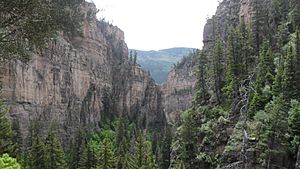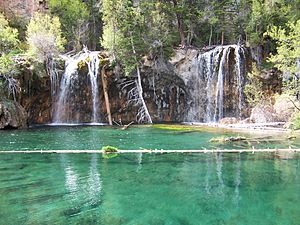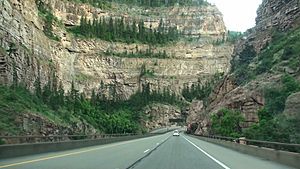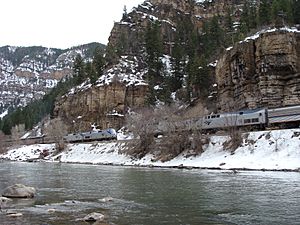Glenwood Canyon facts for kids


Glenwood Canyon is a beautiful and rugged canyon in western Colorado, United States. It stretches for about 12.5 miles (20 kilometers). The canyon walls rise very high, reaching up to 1,300 feet (400 meters) above the Colorado River. It is the biggest canyon of its kind on the Upper Colorado River.
This canyon has always been an important path through western Colorado. Today, it is home to Interstate 70, a major highway. It also carries the Central Corridor railway line. This railway connects cities like Denver and Grand Junction. The canyon starts near Dotsero, where the Eagle River joins the Colorado River. It then goes west-southwest to just east of Glenwood Springs. Most of the canyon is in Garfield County. A small part near Dotsero is in Eagle County.
A Path Through History
Glenwood Canyon has been a key route for a long time. In 1906, the Taylor State Road was built here. This was a gravel road and the first way for cars to travel through the Colorado Rockies. Later, in the late 1800s, the Denver and Rio Grande Western Railroad built its tracks through the canyon. Today, this railway line is part of the Union Pacific system.
The canyon was also a famous spot along the California Zephyr passenger train route. A special monument to the train's unique dome car design was once placed here. However, in the 1990s, it was moved to the Colorado Railroad Museum in Golden. This move made way for the construction of Interstate 70.
Exploring the Canyon
Glenwood Canyon is known as one of the most beautiful natural spots on the Interstate Highway System. You can explore the canyon on foot from four rest areas along Interstate 70. The Hanging Lake Rest Area (exit 125) is a popular starting point. From here, you can access parts of the canyon where I-70 goes through the Hanging Lake Tunnel. Sometimes, the freeway in the canyon can be closed due to rockslides. For example, a rockslide closed it in February 2016.
How the Canyon Was Formed
Glenwood Canyon was formed quite recently in Earth's history, during the Pleistocene time. The Colorado River carved its way quickly through layers of sedimentary rock. The upper parts of the canyon are made of sandstone. This sandstone comes from the Pennsylvanian and Mississippian periods. Some of the lower canyon walls are made of even older Cambrian rock. A notable layer of rock in the upper parts of the canyon is called the Leadville Formation.



